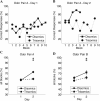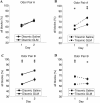Galantamine improves olfactory learning in the Ts65Dn mouse model of Down syndrome
- PMID: 22355654
- PMCID: PMC3216618
- DOI: 10.1038/srep00137
Galantamine improves olfactory learning in the Ts65Dn mouse model of Down syndrome
Abstract
Down syndrome (DS) is the most common form of congenital intellectual disability. Although DS involves multiple disturbances in various tissues, there is little doubt that in terms of quality of life cognitive impairment is the most serious facet and there is no effective treatment for this aspect of the syndrome. The Ts65Dn mouse model of DS recapitulates multiple aspects of DS including cognitive impairment. Here the Ts65Dn mouse model of DS was evaluated in an associative learning paradigm based on olfactory cues. In contrast to disomic controls, trisomic mice exhibited significant deficits in olfactory learning. Treatment of trisomic mice with the acetylcholinesterase inhibitor galantamine resulted in a significant improvement in olfactory learning. Collectively, our study indicates that olfactory learning can be a sensitive tool for evaluating deficits in associative learning in mouse models of DS and that galantamine has therapeutic potential for improving cognitive abilities.
Figures


Similar articles
-
Pharmacological approaches to improving cognitive function in Down syndrome: current status and considerations.Drug Des Devel Ther. 2014 Dec 17;9:103-25. doi: 10.2147/DDDT.S51476. eCollection 2015. Drug Des Devel Ther. 2014. PMID: 25552901 Free PMC article. Review.
-
Epigallocatechin-3-gallate (EGCG) consumption in the Ts65Dn model of Down syndrome fails to improve behavioral deficits and is detrimental to skeletal phenotypes.Physiol Behav. 2017 Aug 1;177:230-241. doi: 10.1016/j.physbeh.2017.05.003. Epub 2017 May 3. Physiol Behav. 2017. PMID: 28478033 Free PMC article.
-
Comprehensive behavioral phenotyping of Ts65Dn mouse model of Down syndrome: activation of β1-adrenergic receptor by xamoterol as a potential cognitive enhancer.Neurobiol Dis. 2011 Aug;43(2):397-413. doi: 10.1016/j.nbd.2011.04.011. Epub 2011 Apr 17. Neurobiol Dis. 2011. PMID: 21527343 Free PMC article.
-
Maternal choline supplementation improves spatial learning and adult hippocampal neurogenesis in the Ts65Dn mouse model of Down syndrome.Neurobiol Dis. 2013 Oct;58:92-101. doi: 10.1016/j.nbd.2013.04.016. Epub 2013 Apr 30. Neurobiol Dis. 2013. PMID: 23643842 Free PMC article.
-
Aging and intellectual disability: insights from mouse models of Down syndrome.Dev Disabil Res Rev. 2013;18(1):43-50. doi: 10.1002/ddrr.1127. Dev Disabil Res Rev. 2013. PMID: 23949828 Review.
Cited by
-
Analysis of adult cerebral cortex and hippocampus transcriptomes reveals unique molecular changes in the Ts1Cje mouse model of down syndrome.Brain Pathol. 2015 Jan;25(1):11-23. doi: 10.1111/bpa.12151. Epub 2014 Jul 25. Brain Pathol. 2015. PMID: 24916381 Free PMC article.
-
Alzheimer's Disease Pharmacotherapy in Relation to Cholinergic System Involvement.Biomolecules. 2019 Dec 26;10(1):40. doi: 10.3390/biom10010040. Biomolecules. 2019. PMID: 31888102 Free PMC article. Review.
-
A systematic-review of olfactory deficits in neurodevelopmental disorders: From mouse to human.Neurosci Biobehav Rev. 2021 Jun;125:110-121. doi: 10.1016/j.neubiorev.2021.02.024. Epub 2021 Feb 18. Neurosci Biobehav Rev. 2021. PMID: 33610612 Free PMC article.
-
Pharmacological approaches to improving cognitive function in Down syndrome: current status and considerations.Drug Des Devel Ther. 2014 Dec 17;9:103-25. doi: 10.2147/DDDT.S51476. eCollection 2015. Drug Des Devel Ther. 2014. PMID: 25552901 Free PMC article. Review.
-
Amyloid-β and Astrocytes Interplay in Amyloid-β Related Disorders.Int J Mol Sci. 2016 Mar 4;17(3):338. doi: 10.3390/ijms17030338. Int J Mol Sci. 2016. PMID: 26959008 Free PMC article. Review.
References
-
- Roizen N. J. & Patterson D. Down's syndrome. Lancet 361, 1281–1289 (2003). - PubMed
-
- Antonarakis S. E., Lyle R., Dermitzakis E. T., Reymond A. & Deutsch S. Chromosome 21 and down syndrome: from genomics to pathophysiology. Nat Rev Genet 5, 725–738 (2004). - PubMed
-
- Hick R. F., Botting N. & Conti-Ramsden G. Short-term memory and vocabulary development in children with Down syndrome and children with specific language impairment. Dev Med Child Neurol 47, 532–538 (2005). - PubMed
-
- Hunter C. L., Bimonte H. A. & Granholm A. C. Behavioral comparison of 4 and 6 month-old Ts65Dn mice: age-related impairments in working and reference memory. Behavioural brain research 138, 121–131 (2003). - PubMed
-
- Benavides-Piccione R. et al.. On dendrites in Down syndrome and DS murine models: a spiny way to learn. Progress in neurobiology 74, 111–126 (2004). - PubMed
Publication types
MeSH terms
Substances
Grants and funding
LinkOut - more resources
Full Text Sources
Other Literature Sources
Medical

